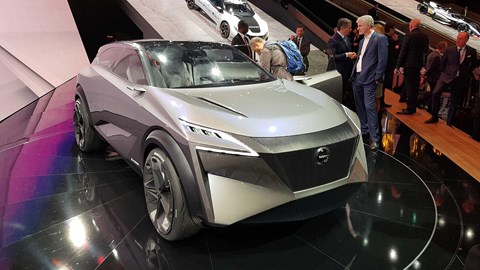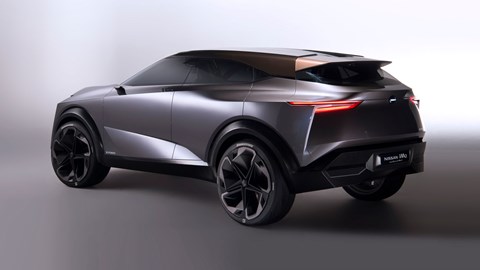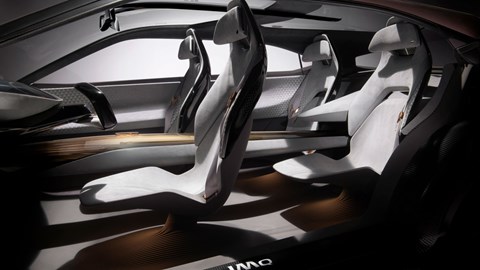► Study for the new Qashqai
► All-electric crossover
► Takes light inspiration from GTR-50
There’s no new GT-R from Nissan at the Geneva motor show in 2019, but there is this, the IMQ concept.
‘IM’ stands for Intelligent Mobility, and while Nissan isn’t disclosing what the ‘Q’ represents, it doesn’t take a genius to work out it’s not quail or quinoa. Given this concept is the size of the Qashqai, a model which is due for replacement soon, then you’re looking at…
…A Lexus NX?

Funny. But that is the elephant in the room. If the next Nissan Qashqai does resemble this concept, then one set of Japanese lawyers might be calling another set of Japanese lawyers to discuss intellectual property copyright.
Leaving that delicate matter aside though, the IMQ is here to preview a bolder new look for the perennial top 10 best-seller in the UK. Nissan is aware that its original Qashqai invented the segment and sat boldly in a class of one, but that its Mk2 follow-up is just one of many.

Don’t expect a swollen Juke, the next Qashqai won’t be as controversial as that, but surrounded by identikit offerings from the VW Group, Nissan wants to put a bit of visual space between it and the competition.
‘It’s a preview of what our next generation of crossovers could look like,’ Nissan Design Europe’s Executive Design Director Matthew Weaver told CAR. ‘We always try and push things a little bit further – we invented some of the crossover segments, and what we’re trying to do here is challenge that again and take leadership. Nissan’s successful when we’re pushing, and we’re pushing quite hard at the moment. We don’t want to just evolve in what is quite a populated segment of the market.’

So what makes it to the production line at Sunderland, and what doesn’t?
‘We’ve reinvented some of the cues that make a crossover,’ explains Weaver. ‘The Juke or current Qashqai are based around the wheelarches, but here the whole body side becomes a wheelarch. The nose pushes out to become a wheelarch with a very wide front end, and then we’re pulling that new flavour of wheelarch out at the rear.’
In short, it’s a push towards the premium end of the market, to deliver a more sophisticated design. And while it’ll be toned down somewhat before the accountants give it the green light, still expect to see the big clean body sides offset against the crisply creased front and rear haunches, as well as the deep ‘V-motion’ grille and the new boomerang headlights.
If the designers get their way, the juxtaposition between the body and the body cladding will feature too. Rather than integrate one into the other, there’s a move to make it look as though the sleek body panels sit atop the more platform beneath. Nissan says this juxtaposition between the clean and the elaborate follows the Japanese principle of ‘Ma’ (or structural harmony, to you and I).
Further adding to the detail side of things are the strakes cut into all the body cladding – Nissan calls them ‘lamellas’. ‘It’s a fresh take on what you usually see on crossovers, with the textures going into the grille and even the exhausts,’ exterior designer Yalim Erkaya told CAR. ‘It’s about bringing texture to the exterior, and highlighting our precision.’

The lamellas are replicated within the interior too, flowing up from the floor to form the seats. Arranged in an ornamental pattern akin to a Japanese garden, it’s all rather calming. Or at least it would be until you were scraping your offspring’s Haribo out of the gaps.
Anything else of note inside?
Open the suicide doors (another concept car folly) and besides the lamellas in the floor, they’re integrated into the door trims, as well as the seats as head rest supports. A big instrumental panel dominates the dash with an 840mm screen that’s invisible until the ignition key is turned. Flowing out from under it and back between the seats is a copper-tinted (because electrical wiring) floating centre console.
More relevant is the two-tone 3D technical fabric that adorns the seats, doors and parcel shelf – it’s laser-cut in a geometric design inspired by Japanese ‘Kumiko’ woodwork. ‘The materials soften the use of technology,’ explains colour designer Priyanka Gaitonde. ‘The ambient lighting is hidden behind the fabric, so the effect is seamless rather than obvious.’
As with the lamellas, it’s another hint that Nissan wants to add a few more distinctive, Japanese-inspired touches to the next Qashqai, so it’s not all black plastic inside.

And the power? Presumably it’s not got a GTR engine under the bonnet?
Not quite. There’s an e-Power powertrain instead, which means it’s an EV. The battery is the same tech as in Nissan’s Leaf, but it’s smaller here because the 1.5-litre petrol acts as a range extender to give you more juice. The engine never drives the wheels, rather that’s the job of an electric motor on each axle, which have combined total outputs of 335bhp and 516lb ft.
It’s probably a step too far and too soon for the next Qashqai to be available as a pure EV, but we expect at least a hybrid offering. Whether that’s an e-Power range-extender like the concept (and which Nissan offers in less powerful 1.2-litre guise in the Note supermini in Japan) or a more conventional set-up, remains to be seen.
As does what Lexus makes of the design…
Further electric car reading
The best electric cars and EVs on sale today
How much does it cost to charge an electric car?
The best hybrids, plug-ins and PHEVs
Wireless electric car charging